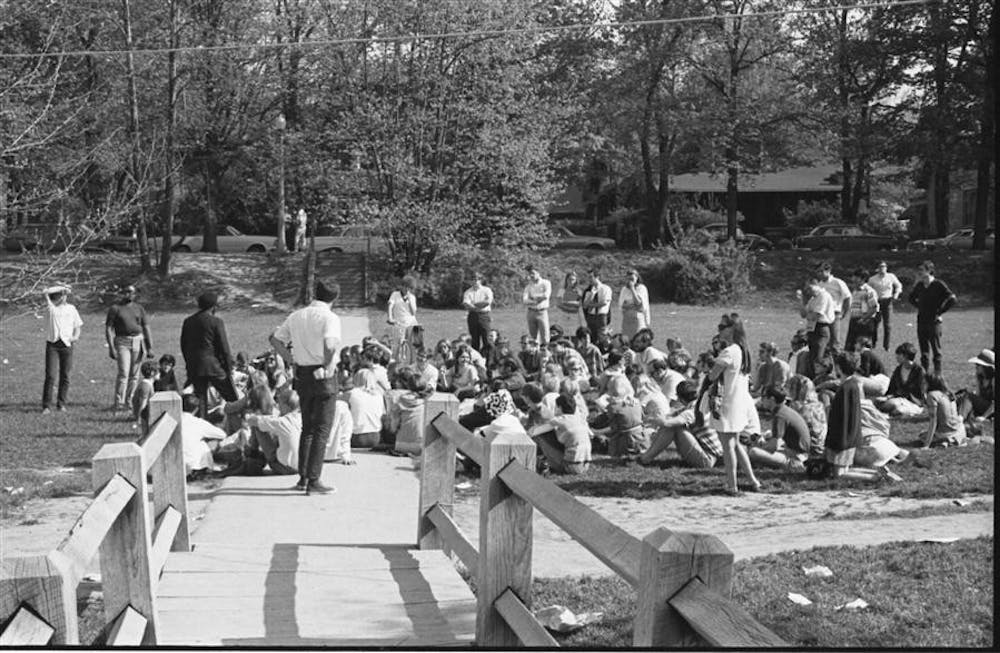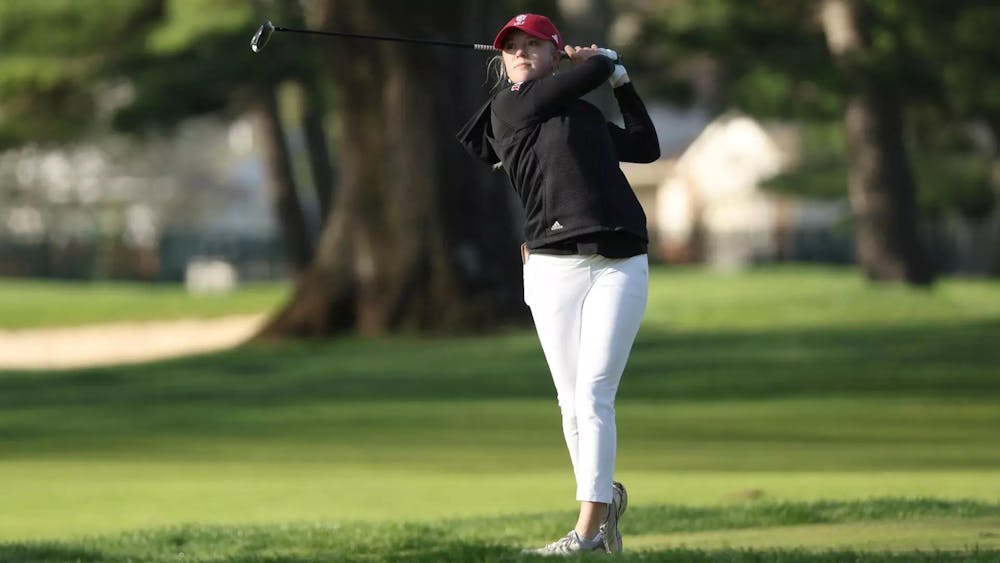This is the story of a plot of earth. Of dirt and grass and mud and rain. A right-angled triangle, 925 feet long by 407 feet wide, intersected by a natural stream.
You have crossed it hundreds of times. Here you have thrown Frisbees, had picnics, walked your dog and flown kites. Some of you have kissed here. Some of you have been shot at here.
This is the story of the soil beneath IU. This is the story of Dunn Meadow.
It wasn’t always picturesque. For most of the 19th century, it was little more than muddy woodland, but to the family who farmed the land it was a meadow nonetheless.
Samuel Dunn, Jr. moved from Kentucky to Bloomington in 1823, wanting to raise his eight children in a state without slavery. He and his wife, Elizabeth, settled and farmed a 160-acre plot of land, which included Dunn Woods and the meadow.
No university existed at the time, only a small state seminary, hardly three years old. Sixty years later, a bolt from the blue would change the course of IU history.
On July 12, 1883, according to Thomas D. Clark’s series “Indiana University: Midwestern Pioneer,” a storm raged over Bloomington and Seminary Square, which was then the campus of the old University.
The three-story science building, built nine years prior, was struck by lightning. In the chaos, no one noticed a fire had broken out.
By the time it was discovered, it was impossible to stop. It destroyed the building and the contents of its library.
This was a heavy blow to the emerging University, which had started as a seminary in 1820, became a college in 1828 and began admitting women in 1867.
This was not the University’s first building to go up in flames.
The Board of Trustees faced a critical decision — rebuild or relocate?
Some on the board believed to have found an ideal plot on which to start fresh — the 160-acre farmland owned by brothers Moses and George Dunn and George’s wife, Emphemise, according to an article in the Monroe County Historian.
Others on the board held fast to the current campus and shunned the asking price.
The Dunns were in conflict themselves, wanting to sell the land as plots for larger long-term gain than what the board was offering.
In Indianapolis on Oct. 5, 1883, the board took a vote on whether to buy 20 acres of Dunn property, including Dunn Woods and the surrounding land — but not the meadow — for $300 an acre. The vote passed by a majority of one, according to Clark’s series.
In those days, Clark wrote, young men and women came on foot or horseback from their hometowns to the new campus, blazing trails in hopes of forging a better future through learning.
Education aside, the campus they arrived at left much to be desired.
Locals grazed their cows in the fields, and hunters shot squirrels from the trees, Clark wrote. The students complained of the lack of proper sidewalks.
When the trip to campus took them through the meadow and across the stream, it meant sinking deep into mud.
It was never the board’s plan to stay confined to 20 acres.
On June 27, 1897, it purchased two more additional tracts of land from the Dunns, expanding the campus to nearly 51 acres, according to a Herald-Telephone article.
The meadow now belonged to the University. Whether it would stay a meadow was another matter.
On Dec. 4, 1908, according to Clark’s series, the Bloomington Telephone announced that the county was suffering its worst drought since 1762. Water distribution across the University was a paramount concern, and many ideas were proposed to combat the drought.
IU alumnus Theodore Frelinghuysen Rose, then chairman of the building and grounds committee who “looked upon the campus as his private domain,” according to Clark’s series, proposed to dam the lower end of Dunn Meadow in order to create a romantic lake and relieve the drabness of a neglected corner of the new campus.
His peers, frightened of ague, malaria and mosquito plague, shot down his idea, according to Clark’s series. Dunn Meadow would never become a pond.
The stream that ran through the meadow was fed by Axtell’s Pond, local historian Lee Ehman said in an e-mail, and was known as Spanker’s Branch.
In the January 1920 Alumni Quarterly, IU President David Starr Jordan wrote, “I once reminded the Board of Trustees that they need name no building for me. I asked only that the brook coming through the campus should be called the River Jordan.”
Although the stream has since been recognized as the Jordan River, the title was made official during a Board of Trustees meeting on Aug. 16, 1994, according to the meeting’s minutes. The vote was unanimous.
In the throes of the Great Depression, the University looked for a way to stimulate the sagging local economy, according to Clark’s series.
With federal funding from the Civil Works Administration, the school decided on a massive undertaking — major works projects beautifying campus buildings and land.
By December 1933, the CWA program had become a major refurbishing venture — buildings were rescued from depressing shabbiness, walks and roadways were built and repaired and the grounds were reworked, for a total cost of $167,052.05 (of which IU supplied $65,493.24).
For the first time the campus was lifted out of mud and snow. Dunn Meadow resembled a meadow at last.
From mud to meadow: a history of Dunn Meadow

Get stories like this in your inbox
Subscribe





